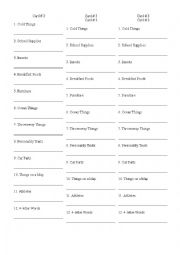


Scattergories Junior: Teams work to come up with different members of different categories (ie. Try some out with your family or use them as inspiration for those on your gift-giving list. Just like in its parent version, two to four players are each given a pad of paper and a category list. Language Pathologists have compiled a list of fun interactive games that work on vocabulary and language skills. Publishers use these marks when books are returned to them. The popular list game is now available with categories just for kids, such as school, animals, pop music, personal likes and dislikes, etc. Remainder Mark - A remainder mark is usually a small black line or dot written with a felt tip pen or Sharpie on the top, bottom, side page edges and sometimes on the UPC symbol on the back of the book.If excessively worn, they will be marked as "tray worn." Flat trays for SPI games are not graded, and have the usual problems.If excessively worn, they will be marked as "card worn." The cardboard backing of miniature packs is not graded.In most cases, boxed games and box sets do not come with dice.Due to the nature of loose counters, if a game is unplayable it may be returned for a refund of the purchase price. Boardgame counters are punched, unless noted.Major defects and/or missing components are noted separately.

Example, EX+ is an item between Excellent and Near Mint condition. the ultimate handbook for kids that introduces tons of games to play by. A "plus" sign indicates that an item is close to the next highest condition. discover the publication Scattergories Cards Lists 1 12 that you are looking for.When only one condition is listed, then the box and contents are in the same condition. Our back-to-school Alphabet Game can be adapted for any occasion Just give your kids a theme and have them fill in the sheets with the corresponding words. Scrabble Junior Game 10,107 41 offers from 8.11 Scattergories Game 5,047 38 offers from 10.00 Scattergories The Card Game Your Favorite Categories Game Meets Slap Jack For At Home, On a Road Trip, or Vacation 2 or More Players Ages 8 and Up 1,155 1 offer from 9.
#Junior scattergories lists code#


 0 kommentar(er)
0 kommentar(er)
